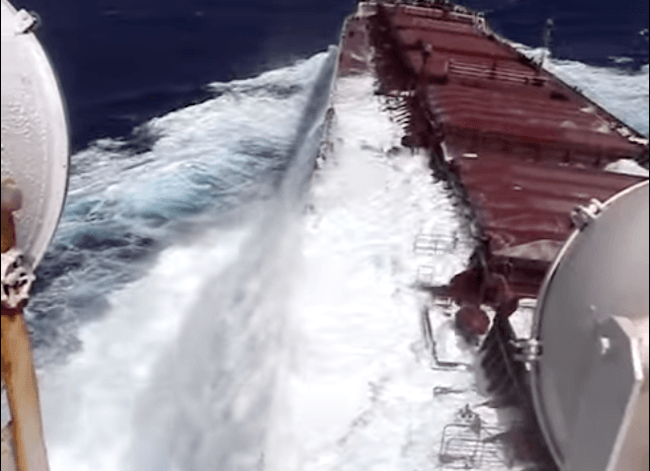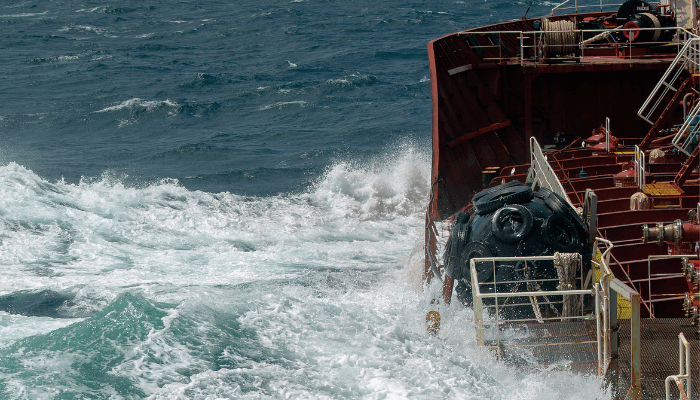What are Rogue Waves?
A ship faces many difficulties at sea, including storms and strong winds. However, one more dangerous factor can capsize the ship in no time – rogue waves.
A rogue wave is a wave which is twice the significant wave height of the region. They are bigger than the other water waves in the surrounding sea at that particular time. Rogue waves can be deadly since they are unpredictable and may strike a ship anytime. They can disable and sink the biggest marine vessels, oil rigs, and floating platforms.
Scientists refer to them as storm waves, appearing as walls of water. They are steep with deep troughs. They have also been a significant part of marine folklore for centuries, and many tales regarding them are pretty popular.
The phenomena of Deadly Rogue Waves
They are terrifying and have drowned many vessels since the advent of sailing. Also termed killer waves, they usually occur in deep waters and have a focusing effect, a consequence of many waves joined together. Their height is twice the height of ordinary waves. More than their height, it is the damage that they create which is more massive.
An interesting fact about rogue waves is that they even form in freshwater, apart from seas and oceans. One of the most renowned 20th-century shipwrecks of Edmund Fitzgerald was the result of a rogue wave on Lake Superior, part of the Great Lakes region of North America.
These freaky waves appear without warning. Though rescue methods can be tried during these waves, they usually fail because, at times, these waves are so quick that precautionary measures fall short. However, it is to note that these waves are not the result of tsunamis, earthquakes or submarines.
Rogue waves can also create eddies, a type of current that flows in another direction than the main current. Often created near the edges of currents, eddies can live for a long time and form vast fields, possessing enormous kinetic energy.
Regions with a lot of current circulations may experience these waves. They are predictable in these areas and confined to a particular site. However, eddies might be distributed over hundreds of kilometres, are less predictable, and can occur anywhere, depending on many geographical factors.
Rogue waves are a natural phenomenon that is not wholly understood, and much research is needed in this direction.

Some notable Encounters of Mariners, Sailors and Researchers
National Geographic’s explorer, Dr Robert Ballard, recounts his encounter with a rogue wave on his first ocean expedition at 17. He calls them one of the most unique and dangerous sea marvels.
He narrated the incident when they were 500 miles off the coast of Eureka, California. They were on a research vessel and stuck in a storm with swells when a rogue wave measuring over 50 feet hit the ship, breaking its windows of the bridge, blowing the portholes, destroying the deck, mast and rails and even flooding the engine room. Thankfully, they made it to shore with the help of a coast guard cutter.
Captain Joshua Slocum is the first person who sailed solo across the world. In 1895, a rogue wave almost took his life when it hit the hull of his sailboat. A cruise ship called Michelangelo was also hit by a gigantic 80 feet rogue wave in 1966. In 2005, the Norwegian Dawn cruise vessel’s ninth and 10th-floor windows were broken by a 70 feet high wave that scared all the passengers and injured two crew members.
Tim Janssen, an expert in Physical Oceanography in Half Moon Bay, California, mentions that the New Year’s Wave is one of the finest examples of rogue waves. On 1 January 1995, an 85 feet high wave hit the Draupner oil platform in the North sea off the coast of Norway. It was one of the first rogue waves observed and recorded with a digital device.
Where and How are Rogue Waves formed?
These freak waves occur in the North Atlantic Ocean, near the Gulf Stream and the North Sea. However, rogue waves form in other places too. They are frequent off the southeastern coast of South Africa. Many scientists have studied this phenomenon and believe the interaction of wave swell with the current causes rogue waves in the area.
Interestingly, when a huge ocean swell strikes the rapidly-moving Agulhas current, it focuses the wave energy like a lens focuses light into a powerful single beam.
When these waves interact with the Agulhas current, their wavelength becomes shorter and steeper, capable of inflicting tremendous damage to sea-going vessels. They are dangerous for bigger ships as they can easily break their hulls.
Experts identify rogue waves as the ones that exceed 25 metres. They are highly potent and often catch the ships from a dangerous angle. Maximum damage is caused if these waves get a destructive entry, which means that these waves go deep and attack the main base of the ship.
Researchers also say that nonlinear effects are the leading cause of their generation. The superimposition of small waves forms a big cluster, commonly known as rogue waves. However, very few people know the exact reason for the generation of these waves. For any person, a rogue wave is the most dangerous thing to happen to a ship. People who have witnessed these waves have only one word to explain: devastating.
Earlier, the forecasting of rogue waves was next to impossible, but technological advancements have made some predictions possible. Satellite tracking of wave formation and motion is one thing used for forecasting rogue waves. With the successful forecast, it has been possible to bring the precautionary measures into action, which has helped in the survival of the ship and the crew.
Recent models of the ships are designed in a way to create deflection for these waves. This deflection, at times, is efficient in handling waves to a particular height.
The frequent formation of these waves is still a mystery for researchers and experts. With sophisticated monitoring and modelling, chances of fighting these waves are now becoming possible.
Environmental engineers from China believe that if a wave propagates from east to west, the current moves just the reverse causing the formation of monster waves. They refer to these waves as monsters, something close to rogue waves.
Frequently Asked Questions
1. How rare is a rogue wave?
Some researches and studies highlight that many waves designated as rogue waves are not freaks but examples of rare wave height distribution. They can occur at a rate of one rogue wave every 28-29 hours.
2. What is the most famous rogue wave?
The first wave that caught the scientific community’s attention was the 1995 Draupner wave that hit the Draupner oil platform in the North Sea. It was a huge wave and one of the first recorded on a digital device. It was 25.6 metres tall or 84 feet, with a peak elevation of 18.5 m.
3. Has a rogue wave sunken a ship?
Modern ships withstand rough conditions at sea, including strong waves. Hence, incidents of recent accidents are not heard of. However, some cruise liners like the Explorer suffered damage from a 55 m tall wave in the North Pacific.
4. Do these waves really exist?
Rogue waves have been a part of marine folklore for many centuries. However, scientists tested and recorded them as real in the 1990s. They are amazing natural phenomena, though everything is not known about them. Many mysteries surround their formation.
5. How predictable are rogue waves?
Rogue waves are enormous waves that can scare you completely. They can strike a vessel unexpectedly from any direction, making them even more dangerous. Rescue operations in such a case might be complicated. They are formed in seas and oceans and also freshwater bodies. They cannot be predicted without complex computational calculations.
You may also like to read
- Effects of Rogue Waves On Ships
- Different Types of Sea Waves – A Comprehensive List
- The World’s Largest Wave Farm
- A Ship with Energy Harvesting System to Generate Power from Waves
- BioWAVE: A Unique Method for Generating Power from Ocean Waves
Disclaimer: The author’s views expressed in this article do not necessarily reflect the views of Marine Insight. Data and charts, if used in the article, have been sourced from available information and have not been authenticated by any statutory authority. The author and Marine Insight do not claim it to be accurate nor accept any responsibility for the same. The views constitute only the opinions and do not constitute any guidelines or recommendations on any course of action to be followed by the reader.
The article or images cannot be reproduced, copied, shared, or used in any form without the permission of the author and Marine Insight.
Do you have info to share with us ? Suggest a correction

About Author
Zahra is an alumna of Miranda House, University of Delhi. She is an avid writer, possessing immaculate research and editing skills. Author of several academic papers, she has also worked as a freelance writer, producing many technical, creative and marketing pieces. A true aesthete at heart, she loves books a little more than anything else.
Subscribe To Our Newsletters
By subscribing, you agree to our Privacy Policy and may receive occasional deal communications; you can unsubscribe anytime.





